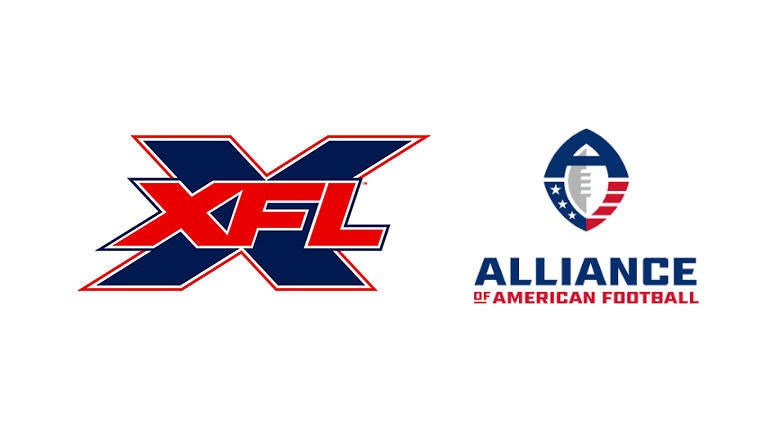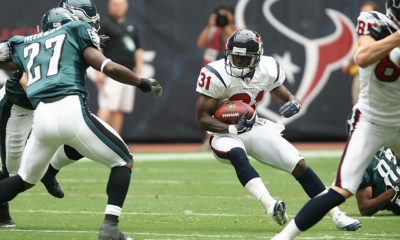
By Mike Mitchell
The Spring Pro Football war that almost was. A year ago at this time, the AAF was racing towards its premiere season. By hook or by crook, the AAF was going to beat the XFL to the market place. The plan as admitted by Bill Polian on ESPN Radio was that the Alliance would get the jump on the XFL and corner the market for the fans’ attention, players, coaches, and executives.
The Alliance of American Football got there first but unfortunately, it didn’t last. The AAF fell victim to the ghosts of spring football’s past. The same sins that killed leagues like NFL Europe, the USFL and UFL led to the demise of the AAF. One can only wonder what might have been had the AAF made it to year two. The existence and then death of the AAF changed the course of the current XFL in so many ways.
TEAM LOCATIONS
A month after the AAF folded. XFL Commissioner Oliver Luck was a guest on Coach Kentera’s 97.3 Radio Show in San Diego. During the interview, Luck was asked about whether the league ever had San Diego in the running, for one of their inaugural 8 cities. Oliver admitted that San Diego was considered on the league’s list for west coast franchises. Oliver admitted that the AAF’s selection and markets affected the city locations that the XFL chose. The XFL didn’t want to have teams in markets where there were already spring pro football teams in existence. The league purposely stayed out of these AAF markets.
Back in December of 2018, months after the AAF chose their eight cities for their inaugural season. The XFL finally revealed the markets that their teams would be playing in for the 2020 season. New York, DC, Tampa, St. Louis, Dallas, Houston, Seattle, and LA. The XFL purposely chose markets that did not have AAF teams. The league did not want to compete head-on with the AAF in the same cities starting in February of 2020. So markets like Orlando and San Diego were not chosen as a result. Those two locations may have been XFL cities rather than Tampa and LA.
St. Louis was almost not an XFL market as well. The Alliance negotiated with the city to bring an AAF team to town but because of scheduling conflicts, the AAF couldn’t get it done for the 2019 season. Instead, the AAF shifted to Salt Lake. This left an opening for the XFL to swoop in and that’s exactly what they did. The entire makeup of XFL2020 and their cities would be completely different today had the AAF not existed.
PLAYER SALARIES
This is where the death of the AAF has mostly changed the game for the XFL and prospective players. The AAF dangled three-year 250,000 dollar contracts for all of their players with 70k guaranteed in year one. To combat this, the XFL was publicly announcing that their player contracts would be higher on average. Specifically for their top-tier players. While current top tier XFL Quarterbacks, according to ESPN’s Kevin Seifert, are slated to make from 125,000 up to 495,000 per season. The rest of the XFL’s player pay structure has changed from the early numbers given out to the media.
Back in February at The NFL Draft Combine. As reported by Darren Rovell of the Action Network. XFL executives like Doug Whaley were on hand to make a pitch to agents for prospective players. Whaley laid out a four-tier potential player salary structure.
Tier I Player: One slot per team. Will make at least $250,000 per season.
Tier II Player: Three slots per team- 24 players in total on eight teams paid six figures per season.
Tier III Player: 23 slots per team. 184 players on the team paid between 75 to under 100k per season.
Tier IV Player: 18 slots per team. Players paid in the 50 to 70k range.
Once the competition in the AAF died. So did the need for the XFL to have higher salaried tiers in place for all of their players. The XFL’s reported salary structure for non-top tier quarterbacks is a 55k average. Like a lot of the XFL’s structure. Nothing was ever set in stone and was always subject to change along the way. There’s no doubt that the Alliance folding changed the XFL’s business structure. The XFL wasn’t going to compete against themselves with no competition on the market. It would have made for some interesting bidding wars for football talent had the AAF survived.
After the Alliance folded, Oliver Luck was a guest on CBS Sports Radio with AAF loyalist and supporter Damon Amendolara. Damon asked Oliver how the XFL would have formed their rosters with Alliance players already under contract. Oliver using knowledge of contract law contended that the AAF’s restrictive NFL only out contracts would not have held up in court once their inaugural season ended. Luck claimed that the XFL would have gone after AAF players regardless. No matter how things would have panned out. It’s clear that the players and their pay would have been the greatest beneficiary of two spring pro football leagues existing at the same time.
PLAYERS
The AAF was employing over 400 football players. The XFL will be doing the same with 416 players on active rosters and 40 plus on the league’s Team Nine. If the AAF had stayed in business. That would have doubled the amount of players playing pro football in the states during the spring.
Former AAF players are a significant part of the over 500 players that are currently on XFL rosters. There are over a hundred former AAF players currently on XFL rosters. Not a large percentage but some of their best young players like Jamar Summers and Rashad Ross are in the XFL. It wasn’t the Alliance’s intention, but they ended up being a proving ground for the XFL. Players got experience and game tape and were able to prove that they should be playing pro-level football just because the AAF existed. XFL teams used AAF games as an additional scouting tool for the players that they drafted.
Even if the XFL had raised the stakes financially to influence AAF players to join their league. There would have been AAF players that decided to stick with their teams in the Alliance, rather than try a new league. The AAF entering year two in decent shape could have also seemed like the more viable destination for prospective players who would have considered playing for an alternate league. Some players may have chosen the Alliance over the XFL.
COACHES/EXECUTIVES
The majority of the XFL’s head coaches were all negotiated with and hired while the AAF season was still in play. The AAF’s pool of head coaches was not in play. The XFL pivoted and landed nicely with the likes of Bob Stoops, June Jones, Pep Hamilton, and others but once the AAF folded. XFL teams started filling their staffs with multiple AAF assistants. Two former AAF head coaches in Mike Riley (San Antonio) and Tim Lewis (Birmingham), ended up taking top assistant roles with Seattle and St. Louis respectively. Each XFL team has multiple quality AAF assistants on them.
Nowhere is the AAF influence more evident than the individual teams’ front offices in the XFL. Daryl ‘Moose’ Johnston did a great job as the GM of the San Antonio Commanders. He was hired to be Bob Stoops Defacto GM as the Director of Player Personnel for the Renegades. Had the AAF stayed in existence, it’s fair to wonder if Moose would even be involved with the XFL at this point. Other former AAF GM’s are now on board with XFL teams in prominent roles. Randy Mueller (Salt Lake-Houston), Josh Hinch (Orlando-Tampa), Trey Brown (Birmingham-St. Louis), Tony Softli (AAF Scouting Director-Seattle), and Trip MacCracken (Arizona-New York). The AAF to XFL bridge also extends to the league office. The AAF’s Director of Player Personnel Russ Giglio joined the XFL as its new Director of Player Administration.
TV DEAL
It would have made for an intriguing February football weekend after the SuperBowl. With AAF games potentially airing head to head with XFL games. Even the XFL’s tv deal was affected by the AAF in many ways. The XFL couldn’t demand any type of rights fee after the Alliance set the market place by paying the networks to air their games. You can’t ask for top dollar if the other similar product is not only supplying the same type of product for free but also paying for it.
When the XFL was in negotiations with ABC and Fox dating back to 2018. The AAF was still in existence. The XFL didn’t negotiate with several networks like CBS or the NFL Network. There was no leveraging between networks because the networks the AAF had in place were off the table. Even the XFL’s tv schedule which was revealed a month after the AAF folded, did not have games airing in Prime Time. Coincidence perhaps… but the AAF had night time games scheduled on NFL Network on Saturdays and Sundays, as well as a few CBS Network scheduled in primetime before they folded.
FINAL SUMMARY
In every field of life, competition usually brings out the very best of everyone. However, there’s no denying that the AAF folding was probably the best possible scenario for the XFL going into year one. An upstart pro league has enough hurdles, to begin with, let alone having to overcome the hurdle of another league just like it. It’s fair to surmise that if the AAF was still around, that the XFL would be an entirely different league.
The AAF proved that there is an appetite for more football. How big of an appetite remains to be seen. The two leagues existing in direct competition would have made for some great theater but it wasn’t meant to be. Players, coaches, and all football-related people would have benefitted from the AAF and XFL existing side by side. It would have doubled the amount of jobs. Even with the Alliance no longer around. Their impact both positive and negative will be tied into the XFL’s for as long as it lasts. It’s all bittersweet. The sweet taste of what might have been and the sour taste that the AAF left believers and non-believers of spring pro football.
Unleash the Action: Sign up for XFL Insider and Fuel Your Passion for Football!
I am a pro football writer who has extensively covered and reported on multiple leagues over the years. I started covering the XFL back in 2001. You can follow me on Twitter @byMikeMitchell

USFL and XFL Merger: A Deep Dive into the Historic Collaboration
Latest Podcast
-


XFL Podcast
/ 1 year agoXFL-USFL Merger Insights: Houston’s Future, Draft News, Player Movement – Ep. 216
Welcome to Episode 216 of the “XFL Week In Review,” your premier destination for...
By Mark Perry







